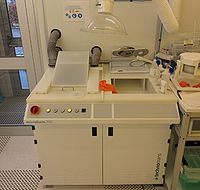Specific Process Knowledge/Thin film deposition/Electroplating-Ni
Feedback to this page: click here
Unless anything else is stated, everything on this page, text and pictures are made by DTU Nanolab.
THIS MACHINE HAS BEEN DECOMMISSIONED
Technotrans microform.200 - DECOMMISSIONED
The Technotrans microform.200 (Electroplating-Ni in LabManager) is a machine capable of depositing nickel electrochemically. This is done by lowering the sample into an electrolyte containing nickel ions and then apply a voltage across the sample and the anode. The anode is a titanium basket filled with nickel pellets. The cathode is the sample to be coated with nickel.
At the anode metallic nickel is oxidized to nickel ions:
Ni (s) ⇒ Ni2+ (aq) + 2 e-
At the cathode (the sample surface), nickel ions from solution are reduced to metallic nickel:
Ni2+ (aq) + 2 e- ⇒ Ni (s)
The minimal charge accepted by the software on the machine is 0.1 Ah (Ampere-hours). This corresponds to roughly 2 µm of nickel on a four inch wafer. You can abort a program prematurely to achieve even lower thicknesses, but this requires manual control of the machine.
The maximum allowed thickness is ~1,4 mm (1400 µm), since a higher thickness will make the release of the sample difficult and likely damage the sample holder. This corresponds to a charge of 53-54 Ah on a four inch wafer. Please contact Nanolab before processing your wafer if you intend to deposit more than ~500 µm of nickel, since this can involve special challenges regarding uniformity, roughness and sample release after plating.
The plating bath is an aqueous solution of nickel sulfamate, boric acid and sulfamic acid. The bath is moderately acidic (pH = 3,70). The pH is kept constant by an automatic pH measurement and sulfamic acid dosing module. The temperature of the bath is 52°C. The sample will spin at 60 RPM during deposition.
Uniformity across a 4" wafer is around 5% for the standard processes (the edge being slightly thicker than the center of the sample). Running at high current densities will deposit a nickel layer that is quite soft. Decreasing current density will increase tensile strength of the deposited nickel.
The user manual(s), quality control procedure(s) and results, user APV(s), technical information and contact information can be found in LabManager:
Electroplating-Ni Info on LabManager
Process information
| Parameter | Value | |
|---|---|---|
| Sample dimensions | Diameter |
50, 100 or 150 mm (~ 2", 4" or 6") |
| Sample thickness |
Maximum 1,0 mm | |
| Process parameters | Temperature |
52°C |
| pH |
3,5 - 3,8 (Recommended by manufacturer) | |
| Sample requirements | Seed metal |
Most commonly ~85-100 nm of NiV |
| Allowed materials |
Most materials allowed. See below. | |
| Forbidden materials |
Copper, cobalt. See machine manual on LabManager for details | |
| Equipment | Electroplating-Ni | |
|---|---|---|
| Purpose |
Electrochemical deposition of nickel | |
| Performance | Thickness |
~20 - 1000 µm |
| Uniformity |
Around 2-10% (depending on sample and process) | |
| Process parameter range | Temperature |
52°C |
| pH |
~3,65 (maintained automatically) | |
| Substrates | Batch size |
|
| Allowed materials |
| |
